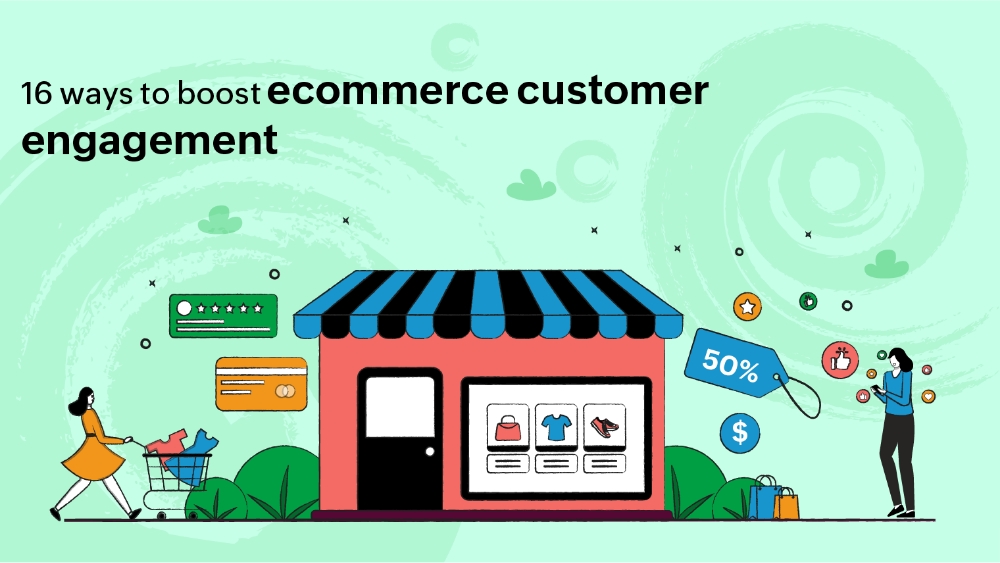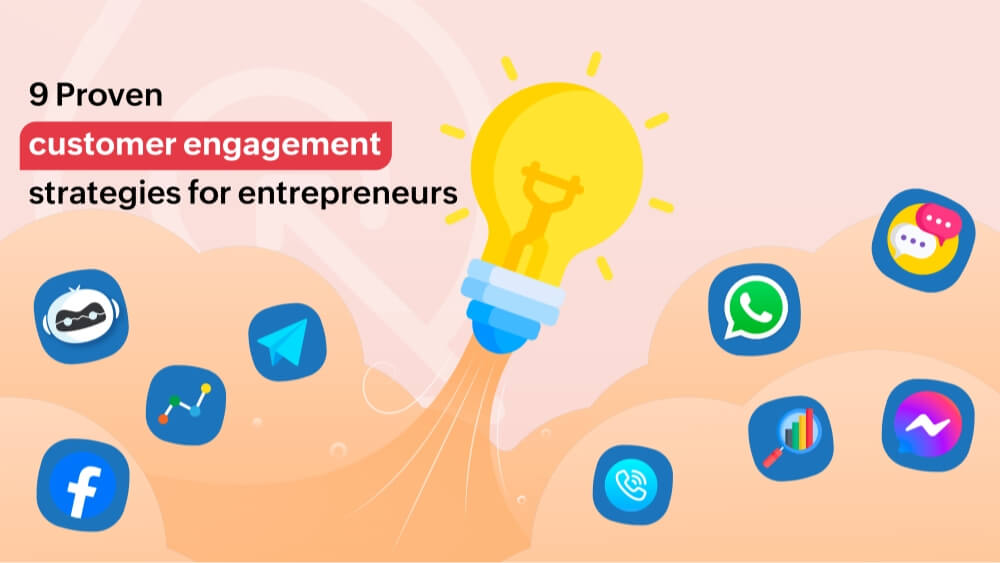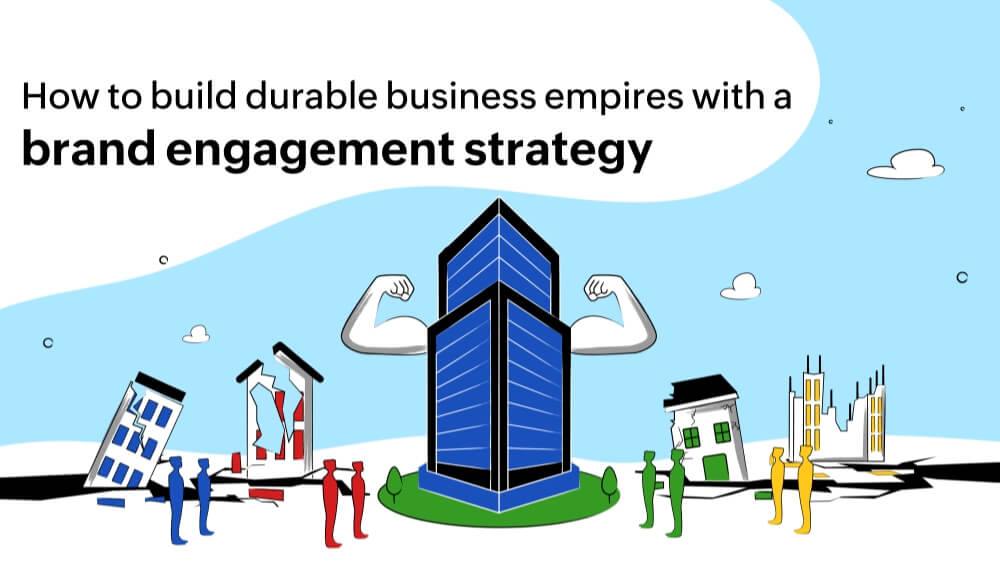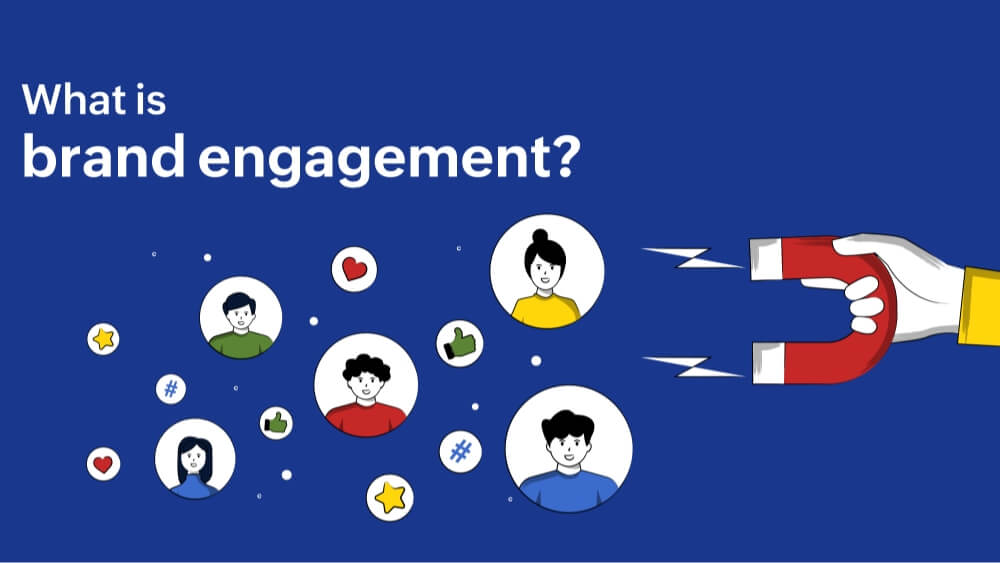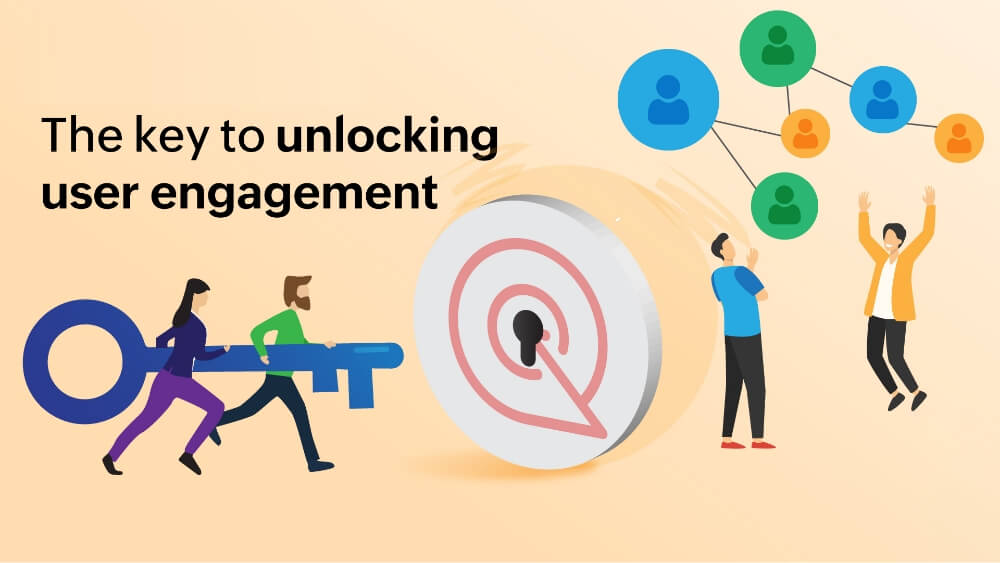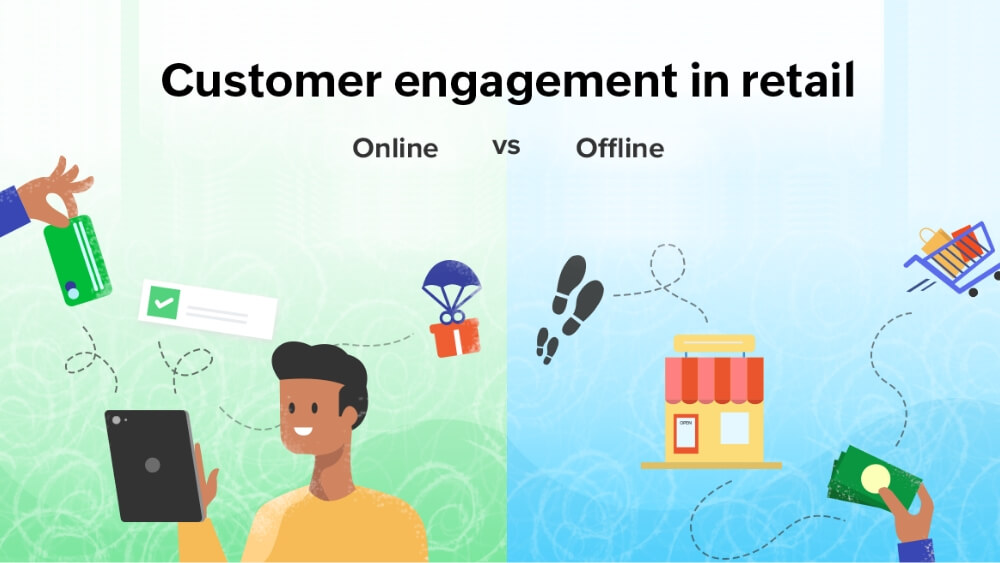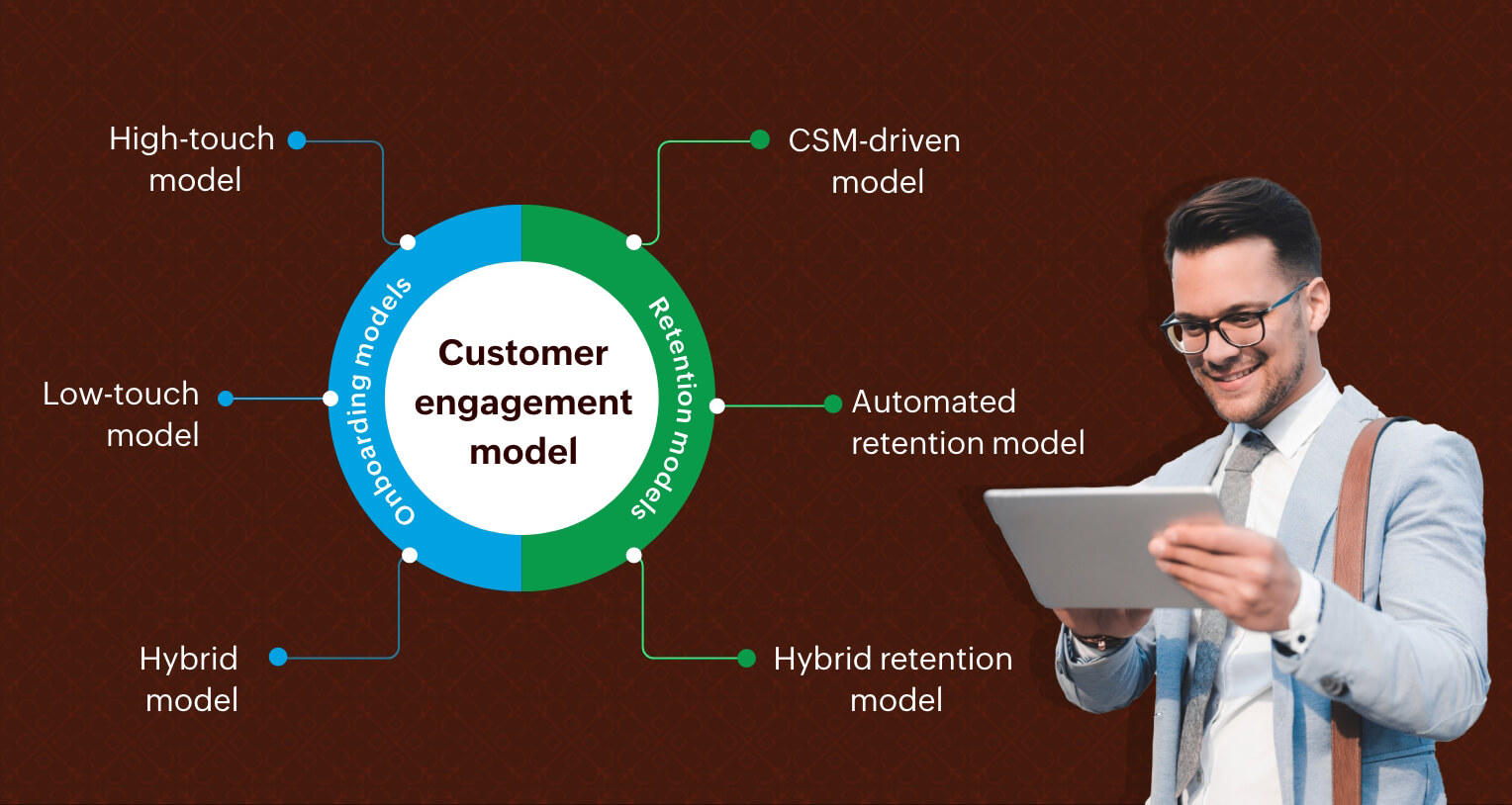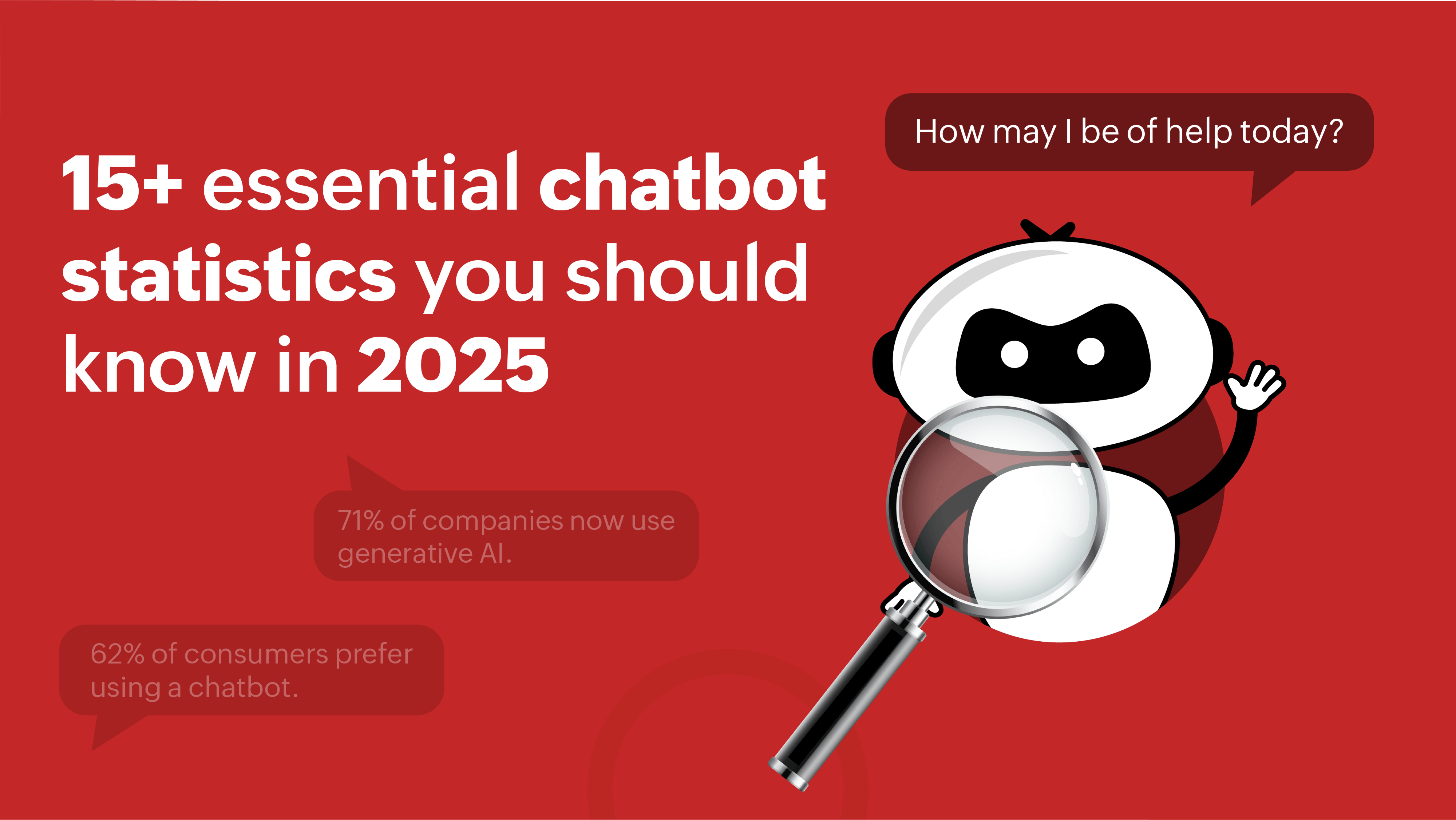What is customer engagement?
Customer engagement (CE) means building and maintaining a good relationship with customers from the moment they first connect with a business. It's about how businesses can understand what customers want, quickly solve their problems, and give them a smooth, reliable experience. This helps build trust and keep customers coming back.

Why is customer engagement important?
Customer engagement has changed the way businesses engage with their customers. It has helped companies stay on top of their customers' minds, earn their support and loyalty, build a strong community around them, and ultimately lead to business growth, such as increased revenue, less churn, and increased customer lifetime value (CLV).
Engage to stay on top
An excellent customer engagement strategy keeps your customers interested in your product or service beyond when they're visiting your website, buying your offerings, or engaging with your business directly.
Even if your business follows a subscription model where customers pay on a monthly or yearly basis, you still need to stay on top of your customers' minds. Otherwise, your business will lose significance in the sea of noise that's out there. If brands don't make an effort to stay relevant, it will be difficult to retain their customers.
If that's the case for subscription-based businesses, consider the challenge for brands that rely on one-time purchases. For them, an engagement strategy is even more critical, as they face a lot of competitors fighting for the attention of potential customers.
To foster continuous engagement, social platforms are one of the best options, as they’ve become a norm for daily entertainment and relaxation. Providing a steady stream of educational content in an entertaining format can help businesses solidify their brand identity and improve brand recall.
If you'd like to learn how to incorporate social media into your customer engagement strategy, check out the discussion 'The Social Media Shift,'' we recently hosted.
Earning customer's support, and loyalty
Gone are the days when you offer low prices and the masses will rush to your doors. Now people are willing to pay a premium to enjoy a great experience with your product/service, and they expect brands to engage them.
If you treat your customers as mere transactions, they'll treat you as just a provider. You can't form and develop a healthy relationship with those dynamics. Only by engaging with them on a continuous basis can you forge a relationship that will earn you their trust and loyalty.
Increasing customer lifetime value
Churn is unavoidable—at some point, even your most loyal customers might jump to your competitors. But when you've got a great engagement strategy and you're consistently engaging with your customers, you can prolong the retention duration and considerably decrease customer churn.
Grow a community that works for you
While most people mention Apple when describing the importance of community, we'll consider Adobe instead. For decades, Adobe has been consistently engaging with its customers.
What's the result?
- It built them an army of supporters who preached and propagated Adobe for free for decades.
- Having multiple products in their kitty helped Adobe cross-sell their products within their community and earned (still earning) them big bucks.
- Adobe used its community to ask about features they'd like to see or to find bugs in their program. This helped them stay relevant for ages without getting outdated by any of their competitors.
- Communities are data mines. Adobe mined and refined the feedback from their customers to understand more about them as well as their target markets. It helped Adobe make their products approachable to everyone.
Benefits of customer engagement for businesses
By now, hopefully you've understood the importance and role of customer engagement in daily business operations. As one of the key factors determining the success of a modern-day business, a wholesome engagement experience can be planned and offered to the customers without any tools.
But having customer engagement software streamlines your strategy, reduces the funnel clutter, nullifies the operational latency, and helps you provide the perfect engagement experience. We'll elaborate on how customer engagement software does that.
Provides multi-channel support
Unlike a few years ago, when websites were the primary point of interaction between businesses and their customers, we've grown much in this space that expanded to include social platforms like WhatsApp, Facebook Messenger, Instagram, and more.
Nowadays, businesses cannot thrive without a strong social presence, and many businesses run only on social platforms without even a website. It proves the extensibility of the social platforms, and not including them in your engagement journey would be a blunder.
Customer engagement software comes with built-in support for all the major social platforms and helps you achieve a leak-proof customer engagement journey that benefits your business.
Eliminates data silos with integrations
As multiple touchpoints are involved in organisations, it'd be next to impossible to collect, collate, and analyze data without any error.
Not just enterprises with complex internal structure and multiple departments—even startups would find it challenging to achieve this. This could prevent businesses from taking any actionable insights from their existing experience journey.
Customer engagement solutions comes with integration options. It automatically combines and collates all data points and eliminates data silos. It makes the manual data transfer between departments redundant, as everything will be available in one place. Businesses can review their experience journey and get actionable insights to better them.
Aids collaboration
Since every department has its share in deciding the customer engagement journey, the multi-channel support and the integration options bring everyone to the table and play a significant role in creating a collaborative workspace.
Automates mundane manual tasks and helps personalization
With the advent of technologies that reduce human intervention in day-to-day business operations, automating mundane manual tasks helps achieve quicker results with less margin for error.
Customer engagement software comes with a bundle of automation features that helps businesses reduce latency in their operation.
Personalization is one of the biggest challenges in creating an engaging experience. But engagement software, with the help of automation features, provides options for creating a personalized experience for all customers and prospects alike.
Customer experience (CX) vs Customer engagement (CE)
- Customer engagementCustomer engagement
- Customer engagement is what you're doing to connect with your customers to build and maintain a healthy relationship via proactive, valuable, timely, and continuous communicationCustomer experience is your customers' overall perception when they see, understand, and interact with your product. Because customers interact with your product/service on multiple fronts—say, marketing, sales, and support—the experience they get out of each of your departments should be uniform.
- Customer engagement aims to create emotional connections with the customers to continue using the offerings.The goal of customer experience is to foster long-term brand loyalty and advocacy by providing a seamless and satisfying journey throughout every touchpoint with the brand.
Strategies to build successful customer engagement
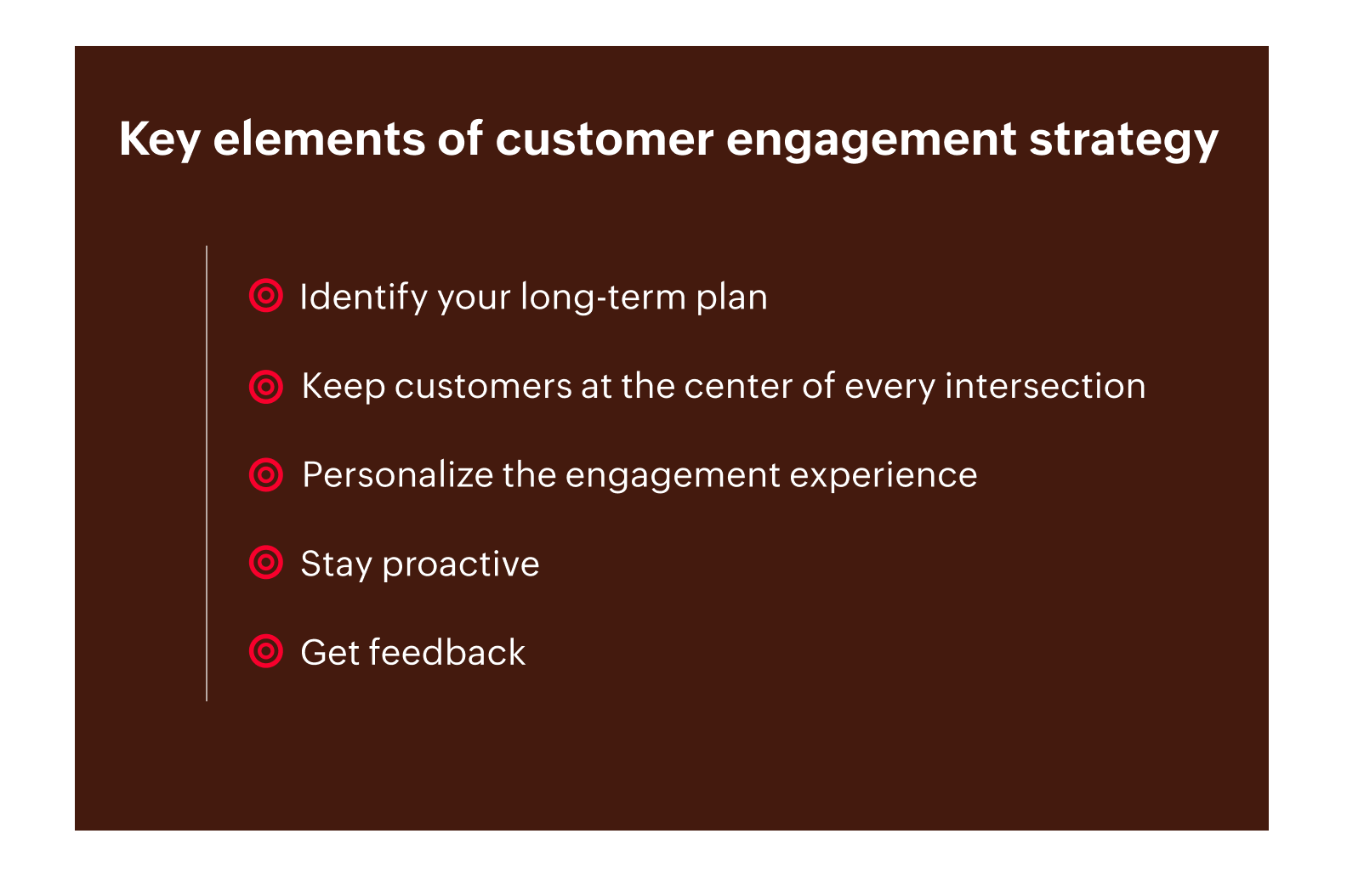
Identify your long-term plan
Many make the mistake of planning a customer engagement strategy in terms of what they should do in one channel like social media or for a short term. Customer engagement shouldn't be a hit-or-miss strategy. Since it's the overall engagement your brand offers, it should be a hit that impresses your visitors and customers.
The strategies you put together will come with you as you bud, bloom, and grow. So don't plan for short-term benefits. If you want to rise to be a brand that enjoys ultimate support from the masses, think about your long-term goals when planning your customer engagement strategies.
Keep customers at the center of every intersection
This is the era of customer-centric strategies, and if you're not adhering to those, you'll be left in the mud all alone. Put yourselves in your customers' shoes and design every point of engagement to delight your customers. Also, make sure you offer value to your customers at every intersection.
Personalize the engagement experience
Personalization is an essential element when constructing customer engagement strategies. You can't please people with mass marketing strategies anymore. If you want to grab their attention and make them your devoted and loyal customers, your engagement strategy should be offer personalized experience.
Stay proactive
Be it for sales, support, or marketing, don't wait for your customers and prospects to reach out to you. Your strategy should be proactive, and it should engage with people even before they decide if they want to initiate a conversation with you. When you're proactive, it makes it easy for them to get back to you.
Get feedback
You're not going to construct a perfect strategy in your first attempt. It'll take some time and iterations to understand what your customers want and the issues they're facing. Make sure you get feedback from your customers at multiple touchpoints. It'll help you identify the issue then and there so you can work on rectifying them.
Customer engagement metrics to measure
Compared to easily measured activities, customer engagement is a tricky one as it involves multiple touch-points sprawling across departments within and outside organizations and doesn't have a simple, direct way of measuring. It's not impossible either. By combining some individual metrics, how engaging your customers benefits your business can be put together. Below are some metrics organizations can keep an eye on to understand the impact customer engagement is bringing them.
1. User actions
Website is the primary communication medium for businesses to talk to their customers. Customer engagement can be measured by measuring some of the users' actions.
Pages per session
The number of website pages prospects visit during a session is measured as pages per session. Measuring pages per session gives an understanding of their interest in your offerings and whether they are getting the information they seek on your pages.
If they're going through multiple pages, it means you're providing relevant content for their needs as well as the pages are interlinked properly. The more time they spend on your site, the more they get to understand the value of your offerings.
If your pages per session are low, consider interlinking to the relevant pages from the page that gets you more traffic and make sure the information is relevant and valuable for them.
Page depth
Every business and website would have an ideal prospect's path. It's the path you'd like to take your prospects through your website for faster and better conversions. Measuring page depth clarifies whether the prospects are taking your ideal path for conversion. If you're not getting the expected conversions, you can see where the drop is happening and rectify it to increase depth.
Average session duration
The average time your prospects spend on your website per session is calculated as the average session duration. A higher average session duration indicates that the prospects are interested in your offerings, and they spend more time getting through them.
Page visit frequency:
How often prospects visit your website is measured via page visit frequency. Higher numbers indicate that they find it helpful to visit your website for knowledge or purchase. Updating information consistently in the format people are interested in will help boost your page visit frequency score.
Bounce rate:
Bounce rate measures the percentage of visitors who return to the initial page after landing on your website without any navigation or engagement. A higher bounce rate indicates they need help finding the information they're looking for on your website. Businesses can make the information visible openly to nudge visitors to engage with them to reduce the bounce rate.
2. Customer Effort Score (CES)
The customer Effort Score measures the effort your customers put in to get the information they need or to get assistance from your customer support team. CES gives a clear indication to prospects that in the future, if they need help, whether it'd be easy to get or not. A lower CES score discourages prospects from becoming your customers as they cannot get the engagement they aspire to.
3. CSAT for customer support
Customer satisfaction (CSAT) score directly measures how your customers feel about your support team. It also indirectly indicates how easy and fast it is to get help from your team and the quality of support you offer.
4. Conversion rate
Though there are multiple factors to consider in prospecting to buy conversion numbers, engagement is also a tiny part of it, as the easier it is to engage with your team, the more conversions will be.
5. Social media engagement
Engagement businesses get across their social channels is also an indication of how their engagement efforts are working out. Even though it's not measurable, unlike those we discussed above, social engagements outline businesses' messaging and how customers/prospects find them. Higher engagement numbers indicate that people relate to your brand and messaging, which is engaging.
By measuring these metrics and combining them, you would give an understanding of if the engagement efforts you're taking with your customers and prospects are working out or not.
If you want to learn more about how to creating an engagement strategy for your business, reading about customer engagement models could help as it offers a holistic view on various models available and which one would be suitable for your business.
Customer engagement trends in 2025
Getting meaningful insights from the data
Businesses have ample data about customers, and we've started seeing the trend of crunching the data to get meaningful insights on how customers engage with companies, their touchpoints throughout the journey, the pain points they face, and more. No collected data will be ignored or overlooked, and no unnecessary data will be collected as customers become privacy-conscious.
Personalized experience at scale
The analyzed data is helping the business personalize every interaction with customers. As AI becomes commercialized with practical business use cases, it can scale the personalized experience to all its customers without increasing headcount or operational costs.
Channels first engagement where WhatsApp dominates
We're already seeing this trend as we have channels-first or even channels-only businesses in operation. The new generation prefers to have instant access to everything, which also reflects how they want their engagement experience to be. It makes perfect sense for businesses to prioritize channels as that's where the target audiences are.
Among the channels, WhatsApp has become the standard mode of communication for all businesses and will continue to be as it holds a large user base.
Zero-party data
As privacy restrictions worldwide tighten and people become more privacy-aware, engagement touchpoints will focus on using Zero-party data and how to use it to provide the best engagement experience to their customers.
*Zero-party data: Data customers share intentionally and proactively with the businesses.
AI in customer engagement journeys
And finally, we can see more inclusion of AI in the customer engagement journey and its touchpoints, as it can help collect, process, analyze, and get insights from data. It can also help businesses provide a personalized experience at scale. Including AI in the customer engagement journey will help companies improve their operational efficiency, optimize their campaigns, automate tasks, and streamline their existing processes, ultimately resulting in loyal customers.
Customer engagement examples
Theories and how-to-do's are fine, but let's discuss how businesses are implementing this in their day-to-day operations.
Amazon
One of the very few companies in the world that's openly customer-centric in everything they do. Amazon has built everything it offers ground up, keeping customers' interests at heart. Wherever you're on the buying journey, Amazon will make sure to have someone to assist you. And they'll prioritize the customers' pain points rather than their corporate policy.
This approach has made them the best platform for people to shop online worldwide. Moreover, with the advanced algorithms, their personalized recommendations based on our search and purchase history are top-notch as they give exactly what the users need. Coupled with the real user feedback, Amazon was able to build a relationship with their customers as they earned their trust and loyalty.
Ikea
Ikea took one of the boring industries and made it fun and engaging by offering a great variation of customization and the way it was presented. The immersive showrooms with fully furnished set-ups are intuitive for everyone to experience their products and visually see how they'll fit in their own home. Along with their astonishing in-store experiences, they've also used the latest technologies such as AR(Augmented Reality) enhance their online experience
To engage the users constantly, they tapped into UGC(User Generated Content) by encouraging DIY projects where their customers can showcase their levels of creativity by sharing it on social platforms.
How to boost customer engagement?
Customer engagement is the strategy businesses build to create and maintain a healthy relationship with their customers. Businesses can achieve this by keeping their customers at the center of their operational axis. Are there any ways businesses can boost their customer engagement? Indeed there is. Let's discuss them.
Omnichannel support and integrations for a single dashboard experience
Customer engagement solutions unite the business' channels. As a result, customers/prospects can reach out to businesses via any channel without having to jump tabs to contact them.
An integration option creates a single dashboard experience for users instead of switching tabs to gather, collate, and analyze data to get actionable insights. By offering omnichannel customer support and integrations, you remove the barrier that causes inconvenience and boosts your engagement experience.
Flawless communication
Customer engagement strategy revolves around creating avenues for customers to contact the business at any point of interaction.
Having the option to contact marketing, sales, or support personnel at any stage gives control to the customers, and they can reach out to clarify their queries, if any. Giving freedom and control to your customers helps boost customer engagement, as they'll be able to contact you at any point of interaction.
Better customer support
The communication criteria extend to support, where customers spend most of their time interacting with businesses. Marketing may pull leads and quality prospects. Sales may attend and convert them, but how your customer support operates determines if the converted customers will be there with you for a long time.
Better customer support makes your customers reach out to your team whenever they're in need, and it helps boost your customer engagement.
Personalization
No visitors want to be greeted with a generic welcome message, and no one wants to be a part of mass mailer campaigns anymore. They expect individualism and want to be treated as if the brands are talking to them in person.
Personalization has been the secret sauce for businesses that are doing well. Increase personalization based on what the visitors do and how they interact with you. Personalizing customer experience helps boost overall customer engagement between visitors and businesses.
Listening to customer feedback
Listening to customer feedback and addressing them on time gives confidence to your customers that you're listening to their opinions. It increases their trust and loyalty to your brand and makes them come to you whenever they need to express anything. It helps boost customer engagement and ultimately plays a significant role in reducing churn and retaining customers.
What are the best customer engagement tools?
With businesses going online, we don't have the luxury of seeing visitors in person, understanding their intent, interacting with them to grasp their needs, and making the sale.
However, doing business online has its own perks. Unlike in a physical store where the visitors leave, online doesn't have that demarcation, and they can be reached over multiple channels. Businesses that build a great engagement strategy grow and succeed.
If you want to implement the strategies for your business as well, you have several customer engagement tools available. We'll discuss five such engagement tools you can employ.
5 best customer engagement tools
1.Email marketing tools
In the ever-changing marketing industry, where the techniques that worked yesterday might not bring results today, email marketing still holds a higher success rate than any other.
Emails have been the primary engagement method as they offer personalization, a scope for continuous communication, and scalability, as well as being an affordable option for businesses.
2.CRM
As the complexities around managing businesses increase, having customer relationship management tools becomes essential for daily operations as every customer matters, and it would be incredibly difficult to manage them from an Excel sheet.
As discussed above, CRM deals with recording the prospect's history from when they become leads until they convert. It's a customer database from where your teams can pull in information about the customers and their journey with you.
CRM plays a massive role for sales executives as they move prospects along the sales funnel, and the CRM features can help them automate their funnel flow for quicker and higher conversion.
You can check out our CRM-live chat software domain insight for understanding the general aspects of the CRM-SalesIQ integration and what it can do for your business.
3.Social media management tools
Whether we accept it or not, social platforms have become an integral part of businesses and are here to stay. Also, the increasing number of social channels poses a discomfort for businesses.
How?
Customers expect businesses to be there in all those channels, and they want options to reach out to businesses from their choice of social channel. That makes managing social platforms challenging.
Businesses also need a management tool to manage all the social platforms from a single dashboard for productivity and quicker resolution. Social media management tools come to the rescue to engage customers.
4.Survey and customer feedback tools
Surveying and customer feedback tools are equally—if not more—important than most engagement tools. You may ask why since they don't contribute to businesses getting leads or gaining revenue.
Well, they play a crucial role in knowing and understanding your customer base. They help businesses learn about how customers use their products and what they would want to get a better experience. They also provide a platform for your customers to reach out instead of venting on social platforms.
5.Live chat and chatbots
Live chat has the advantage of engaging customers/prospects in mere seconds during any stage of the marketing and sales funnel. A live chat widget on the website shows visitors that help is available anytime. It gives them the confidence to try your product and initiate a conversation with your business.
Live chat software plays a crucial role in the support team as customers expect quicker resolution, and live chat has the lower SLA in the industry. Live chat can be combined with chatbots to take a load off support executives without missing even a single query from visitors/customers.
Especially if you've a small team, deploying chatbots would handle almost half of the queries, enabling your support executives to attend to essential queries.
You can measure the effectiveness of your customer engagement tools with customer effort score as it gives an understanding of how your customers find your engagement strategies. Based on the score, businesses can tweak them to achieve their maximum potential.
Build better customer engagement with Zoho SalesIQ
Zoho SalesIQ, a customer engagement solution, comes with excellent built-in features and integration options that can help you engage with your customers better at the three pillars of customer interaction: marketing, sales, and support.
Features like visitor tracking/live view, lead scoring, and AI-based profile enrichment for companies can help you create different engagement strategies for different people based on how they're interacting with your website. Using our proactive live chat, you can instantly engage with them, resolve any queries they have, and cultivate a relationship that goes beyond business. SalesIQ also offers multiple messaging channels integrations that will empower your support team to better serve your prospects and customers.
If you'd like to learn more about how Zoho SalesIQ can help you in customer engagement, check out our customer engagement strategy blog.
Related resources
Here are some blogs to help you build the best customer engagement strategy and implement it for your business.
FAQs about customer engagement
What’s the ROI of investing in a customer engagement platform?
Investing in customer engagement platforms helps businesses provide a uniform and consistent engagement experience across all their touchpoints. It allows enterprises to earn their prospects/customers' trust, fasten the buying cycle, increase the conversion rate, decrease churn, and boost satisfaction scores, ultimately leading to an increase in revenue.
How can I personalize communication to increase engagement rates?
To personalize communication on a large scale, businesses need to collect data on customer behavior, interaction history, and preferences to segment them into categories. By segmenting, messages can be crafted subjectively to suit their needs. Personalization can start with using their names, suggesting solutions based on what they browsed or their purchase history, adding them to a newsletter, etc.
How do live chat and chatbots enhance customer engagement??
Live chat and chatbots are the bridge that helps prospects/customers contact businesses. Because they're available 24/7 and can help get replies and resolutions instantly, they encourage visitors to engage often, leading to an enhanced overall engagement experience.
What features should I look for in a customer engagement platform?
Since customer engagement involves multiple touchpoints, the platform should have multichannel/omnichannel capabilities and be able to integrate seamlessly with your CRM, help desk, and other operational software, as it needs to have the customer information available across touchpoints. Scalability and ease of use are the other characteristics you should look for in an engagement solution.
